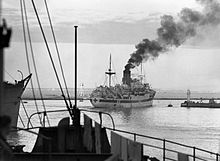HMHS Newfoundland
|
||||||||||||||||||||||
|
||||||||||||||||||||||
|
||||||||||||||||||||||
|
||||||||||||||||||||||
The HMHS Newfoundland was a British hospital ship that fell victim to an air raid by several Dornier Do 217 K2s of Kampfgeschwader 100 of the German Air Force on September 13, 1943 off the Italian port city of Salerno . The ship was sunk the following day because it was too badly damaged.
history
The 6791 GRT steamship Newfoundland was built at Vickers-Armstrongs, Ltd. built in Barrow-in-Furness for the British shipping company Furness, Withy & Co. based in West Hartlepool . The 123.78 m long and 16.89 m wide ship was built as a passenger and cargo ship for the route Great Britain - Canada and was launched on January 15, 1925. It was completed in June 1925. The RMS Nova Scotia (6,796 GRT) put into service in 1926 was an identical sister ship .
At the beginning of the Second World War , the steamer was used as HMHS (His Majesty's Hospital Ship) Newfoundland as a hospital ship. She transported injured soldiers from the United Kingdom to Canada and brought recovered forces back to Europe on the way back. The ship operated mainly between Liverpool and Halifax . After the Allied invasion of Italy in September 1943, the Newfoundland was assigned to the 8th Army as a hospital ship .

She was one of two ships that brought a total of 103 American nurses to Salerno on September 12, 1943 . Shortly afterwards a third hospital ship was added. On that day, the three ships were attacked twice by German dive fighters. For this reason it was decided that the Newfoundland should anchor far outside the city and wait there for the night. That night the ship was brightly lit so that the Red Cross was clearly visible on her hull . As a hospital ship, she was protected by the Geneva Conventions . On the same evening a ceremony was held in honor of the United States Navy Nurse Corps on board .
On Monday, September 13, 1943, the Newfoundland was anchored about 40 nautical miles from Salerno under the command of Captain John Eric Wilson, a bearer of the Order of the British Empire , when she was at 5 o'clock in the morning from German Donier Do 217 K2 of Kampfgeschwader 100 was hit with anti-ship missiles of the type Fritz X. The explosive struck on the boat deck behind the bridge one. All means of communication and fire fighting have been suspended. The oil bunkers caught fire and the ship went up in flames. In addition to the crew, American nurses, 14 British nurses from the Queen Alexandra's Imperial Military Nursing Service (QAIMNS), 34 medical professionals and two patients were on board.
While the USS Mayo , a destroyer of the US Navy , took on board the crew, patients and nurses, remained a small group of crew members consisting of Captain Wilson and 17 other volunteers aboard the Newfoundland who fought for 36 hours against the fire. However, the ship was so badly damaged that it was towed out to sea by the destroyer USS Plunkett and sunk there.
Six British nurses, four crew members, five doctors and six other members of the medical staff were killed in the attack by the German Air Force. No reason for the attack was ever established. It is believed that the German Air Force mistook the Newfoundland for a troop transport despite its paintwork, or that the American nurses were mistaken for soldiers because of their green uniforms.
literature
- Evelyn Monahan, Rosemary Neidel-Greenlee. And If I Perish: Frontline US Army Nurses in World War II. Alfred A. Knopf, Inc., New York, November 4, 2003.
Web links
- Description of the sinking of Newfoundland in a December 15, 2004 BBC article
- Eyewitness report from surviving nurse Vera Schofield
Individual evidence
- ↑ Jürgen Rohwer, Gerhard Hümmelchen: Chronicle of the Sea War 1939–1945, September 1943. Retrieved on February 16, 2019 .

